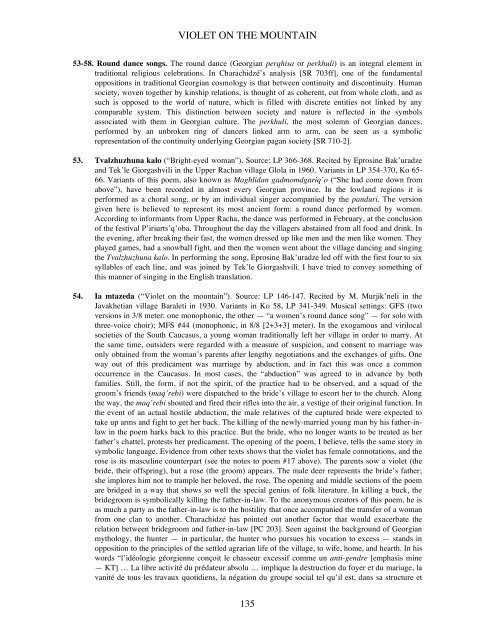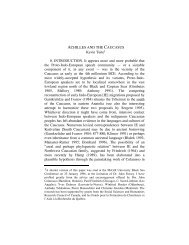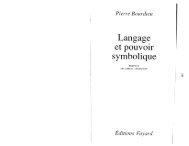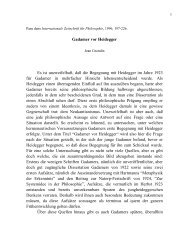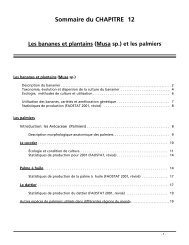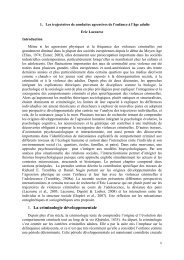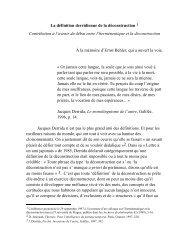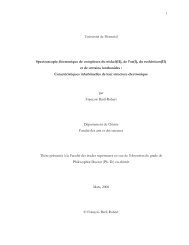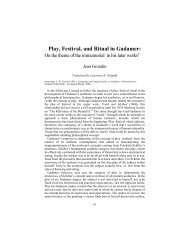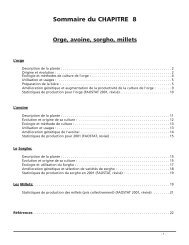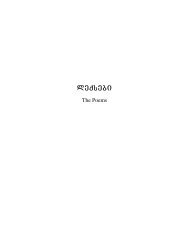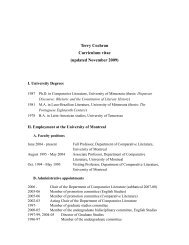You also want an ePaper? Increase the reach of your titles
YUMPU automatically turns print PDFs into web optimized ePapers that Google loves.
VIOLET ON THE MOUNTAIN<br />
53-58. Round dance songs. The round dance (Georgian perqhisa or perkhuli) is an integral element in<br />
traditional religious celebrations. In Charachidzé’s analysis [SR 703ff], one of the fundamental<br />
oppositions in traditional Georgian cosmology is that between continuity and discontinuity. Human<br />
society, woven together by kinship relations, is thought of as coherent, cut from whole cloth, and as<br />
such is opposed to the world of nature, which is filled with discrete entities not linked by any<br />
comparable system. This distinction between society and nature is reflected in the symbols<br />
associated with them in Georgian culture. The perkhuli, the most solemn of Georgian dances,<br />
performed by an unbroken ring of dancers linked arm to arm, can be seen as a symbolic<br />
representation of the continuity underlying Georgian pagan society [SR 710-2].<br />
53. Tvalzhuzhuna kalo (“Bright-eyed woman”). Source: LP 366-368. Recited by Eprosine Bak’uradze<br />
and Tek’le Giorgashvili in the Upper Rachan village Glola in 1960. Variants in LP 354-370, Ko 65-<br />
66. Variants of this poem, also known as Maghlidan gadmomdgariq’o (“She had come down from<br />
above”), have been recorded in almost every Georgian province. In the lowland regions it is<br />
performed as a choral song, or by an individual singer accompanied by the panduri. The version<br />
given here is believed to represent its most ancient form: a round dance performed by women.<br />
According to informants from Upper Racha, the dance was performed in February, at the conclusion<br />
of the festival P’iriurts’q’oba. Throughout the day the villagers abstained from all food and drink. In<br />
the evening, after breaking their fast, the women dressed up like men and the men like women. They<br />
played games, had a snowball fight, and then the women went about the village dancing and singing<br />
the Tvalzhuzhuna kalo. In performing the song, Eprosine Bak’uradze led off with the first four to six<br />
syllables of each line, and was joined by Tek’le Giorgashvili. I have tried to convey something of<br />
this manner of singing in the English translation.<br />
54. Ia mtazeda (“Violet on the mountain”). Source: LP 146-147. Recited by M. Murjik’neli in the<br />
Javakhetian village Baraleti in 1930. Variants in Ko 58, LP 341-349. Musical settings: GFS (two<br />
versions in 3/8 meter: one monophonic, the other — “a women’s round dance song” — for solo with<br />
three-voice choir); MFS #44 (monophonic, in 8/8 [2+3+3] meter). In the exogamous and virilocal<br />
societies of the South Caucasus, a young woman traditionally left her village in order to marry. At<br />
the same time, outsiders were regarded with a measure of suspicion, and consent to marriage was<br />
only obtained from the woman’s parents after lengthy negotiations and the exchanges of gifts. One<br />
way out of this predicament was marriage by abduction, and in fact this was once a common<br />
occurrence in the Caucasus. In most cases, the “abduction” was agreed to in advance by both<br />
families. Still, the form, if not the spirit, of the practice had to be observed, and a squad of the<br />
groom’s friends (maq’rebi) were dispatched to the bride’s village to escort her to the church. Along<br />
the way, the maq’rebi shouted and fired their rifles into the air, a vestige of their original function. In<br />
the event of an actual hostile abduction, the male relatives of the captured bride were expected to<br />
take up arms and fight to get her back. The killing of the newly-married young man by his father-inlaw<br />
in the poem harks back to this practice. But the bride, who no longer wants to be treated as her<br />
father’s chattel, protests her predicament. The opening of the poem, I believe, tells the same story in<br />
symbolic language. Evidence from other texts shows that the violet has female connotations, and the<br />
rose is its masculine counterpart (see the notes to poem #17 above). The parents sow a violet (the<br />
bride, their offspring), but a rose (the groom) appears. The male deer represents the bride’s father;<br />
she implores him not to trample her beloved, the rose. The opening and middle sections of the poem<br />
are bridged in a way that shows so well the special genius of folk literature. In killing a buck, the<br />
bridegroom is symbolically killing the father-in-law. To the anonymous creators of this poem, he is<br />
as much a party as the father-in-law is to the hostility that once accompanied the transfer of a woman<br />
from one clan to another. Charachidzé has pointed out another factor that would exacerbate the<br />
relation between bridegroom and father-in-law [PC 203]. Seen against the background of Georgian<br />
mythology, the hunter — in particular, the hunter who pursues his vocation to excess — stands in<br />
opposition to the principles of the settled agrarian life of the village, to wife, home, and hearth. In his<br />
words “l’idéologie géorgienne conçoit le chasseur excessif comme un anti-gendre [emphasis mine<br />
— KT] … La libre activité du prédateur absolu … implique la destruction du foyer et du mariage, la<br />
vanité de tous les travaux quotidiens, la négation du groupe social tel qu’il est, dans sa structure et<br />
135


